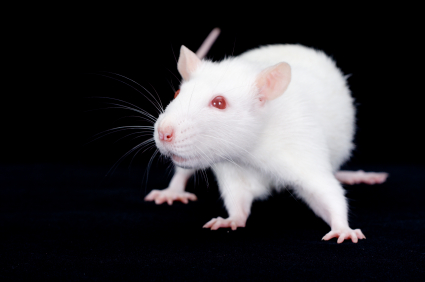Clarifying the role of melatonin receptors in sleep
The antidepressant agomelatine (which is available in many countries, but not the US) and the anti-insomnia drug ramelteon (Rozerem) both act as agonists at melatonin M1 and M2 receptors. New research is clarifying the role of these receptors in sleep.
In new research from Stefano Comai et al., mice who were genetically altered to have no M1 receptor (MT1KO knockout mice) showed a decrease in rapid eye movement (REM) sleep, which is linked to dreaming, and an increase in slow wave sleep. Mice who were missing the M2 receptor (MT2KO knockout mice) showed a decrease in slow wave sleep. The effects of knocking out a particular gene like M1 or M2 end up being opposite to the effect of stimulating the corresponding receptor.
The researchers concluded that MT1 receptors are responsible for REM sleep (increasing it while decreasing slow wave sleep), and MT2 receptors are responsible for slow wave non-REM sleep.
The new information about these melatonin receptors may explain why oral melatonin supplements can make a patient fall asleep faster, but do not affect the duration of non-REM sleep. The authors suggest that targeting MT2 receptors could lead to longer sleep by increasing slow wave sleep, potentially helping patients with insomnia.
Fear Memories Can Be Erased or Provoked in Animals
Researchers have identified neurons responsible for remembering conditioned fear in the amygdala of rodents, and can turn them on and off. At the 2013 meeting of the Society of Biological Psychiatry, Sheena A. Josselyn gave a breath-taking presentation on this process.
When animals hear a tone they have learned to associate with the imminent delivery of a shock in a given environment, they learn to avoid that environment, and they reveal their learning of the tone-shock association by freezing in place. Josselyn was able to observe that 20% of the neurons in the lateral nucleus of the amygdala were involved in this memory trace. They were revealed by their ability to increase the transcription factor CREB, which is a marker of cell activation. Using cutting-edge molecular genetic techniques, the researchers could selectively eliminate only these CREB-expressing neurons (using a new technology in which a diphtheria toxin is attached to designer receptors exclusively activated by designer drugs, or DREADDs) and consequently erase the fear memory.
The researchers could also temporarily inhibit the memory, by de-activating the memory trace cells, or induce the memory, so that the animal would freeze in a new context. Josselyn and colleagues were able to identify the memory trace for two different tones in two different populations of amygdala neurons.
The same molecular tricks with memory also worked with cocaine cues, using what is known as a conditioned place preference test. A rodent will show a preference for an environment where it received cocaine. Knocking out the selected neurons would remove the memory of the cocaine experience, erasing the place preference.
The memory for cocaine involved a subset of amygdala neurons that were also involved in the conditioned fear memory trace. Incidentally, Josselyn and her group were eventually able to show that amygdala neurons were in competition with each other as to whether they would be involved in the memory trace for conditioned fear or for the conditioned cocaine place preference.
The Myth of Neurogenesis in Adult Primates Debunked
In a plenary lecture at the Collegium Internationale Neuro-Psychopharmacologicum (CINP) in Istanbul in 2012, Pasco Rakic, professor of neuroanatomy at Yale University, may have debunked a myth of modern medicine, one that we have cited in many previous BNNs. Despite what has been written by famous neuroscientists and published in the most prestigious journals, including Science, Cell, and PNAS, based on data in rodents, Rakic presented evidence that neurogenesis does not occur to any substantial extent in adult primates.
Two decades ago, data in rodents and other species clearly indicated that neurogenesis, the creation of new neurons, occurred in adult animals, especially in the dentate gyrus of the hippocampus. Thousands of papers were written on the subject, and neurogenesis was understood to be possible in adult humans as well. It was even suggested based on data in rodents that the mechanism of action of antidepressants was dependent on neurogenesis. However, Rakic argues that most of the research on neurogenesis was based on faulty data.
Rakic found that while rats do have neurogenesis into adolescence, it diminishes greatly in older adult animals. In primates, neurogenesis in the cortex ends before birth. In the primate dentate gyrus of the hippocampus, there is some postnatal neurogenesis, but it rapidly drops toward zero in the first months of life. Rakic concludes: “We are as old as our neurons…or slightly younger.”
Why should primates have permanent stores of neurons when rodents and other lower animal species get new ones further into their lifespan? Rakic postulates that for primates, neurons must hold experience-dependent memories necessary for the survival of the species, and turning them over would endanger the permanence of this memory. Whatever the reason, it is disappointing to find out that the revolutionary discovery of adult neurogenesis in rodents so widely presumed to also occur in adult primates and humans may not be correct.
This has clinical implications. If we don’t get replacement hippocampal neurons like rats do, it is even more important to protect the billions of neurons that we do have. There are many things that endanger neurons, including inflammation, oxidative stress, high cortisol, poor diet, psychosocial adversity, and episodes of depression and mania. Greater numbers of mood episodes are associated with increasing degrees of cognitive dysfunction because of these many factors. A startling statistic from Denmark by Lars Kessing is that having four or more hospitalizations for depression (either unipolar or bipolar) doubles the risk for a diagnosis of dementia in late life. Thus, it looks like too many episodes hurt the brain.
However, on the positive side, the mood stabilizers (lithium, lamotrigine, valproate, and carbamazepine) and some atypical antipsychotics prevent episodes and increase the neuroprotective factor BDNF, or brain-derived neurotrophic factor, which facilitates synaptogenesis and helps protect neurons. BDNF is produced in selected neurons in the brain and decreases with stress and affective episodes, further endangering neurons. Since many effective treatments both prevent episodes and their associated decreases in BDNF and also directly increase BDNF, they may be having a dual positive benefit. The evidence is best for lithium having neuroprotective effects that can be directly observed in humans. Thus a not unreasonable mantra for patients with recurrent mood disorders is: “Prevent Episodes, Protect the Brain.”




